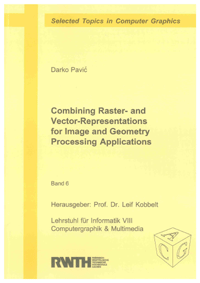
Catalogus : Recensies
Recensies

|
Darko Pavic Combining Raster- and Vector-Representations for Image and Geometry Processing Applications Volume 6 ISBN: 978-3-8322-9224-9 Prijs: 48,80 € / 97,60 SFR |
|---|---|
| Summary: Geometric information is omnipresent in any data used as input in computer graphics applications. While this is obvious for geometry processing applications, where 3D models are the objects of interest, it is not directly apparent in the case of image and video processing applications. However, there are at least two di_erent views for interpreting images as representations for geometric information. First, images can be seen as height _elds over spatial 2D domains and as such describe geometric shapes in the used color space. Second, images show projected 3D geometry, which we can describe or at least approximate and exploit. In order to take advantage of the provided geometric information in the input data, the key issue is to find the most appropriate geometry representation which is perfectly suited for specific application´s requirements. In this thesis we show that a combination of raster- and vector-representations of the geometric information contained in the input data provides novel opportunities and ways for solving very challenging tasks in the areas of image and geometry processing. By this we also draw parallels between these two, at first glance, completely different areas in computer graphics, and show a way to address problems posed in these areas in a uni_ed manner. We present a number of novel approaches which provide several improvements over previous works by appropriate recovery and exploitation of different geometry representations in the input data. In the first part of this thesis we show how to efficiently represent and exploit geometry in the color space for a number of image processing tasks. The standard raster-representation of an image is extended inside the concept of Two-Colored Pixels (TCPs) with an appropriate vectorization of the geometric information in the color space. We exploit the same TCP concept as a basic operator for an interactive brush tool, as a supporting data structure for retargeting applications and also as a feature/non-feature classifier for the computation of genuine image mosaics. In the context of our mosaicing algorithm, for matching we propose polynomial image descriptors as a very compact geometric representation of an image in the color space. In the second part of this thesis we interpret an image as a container for the projected 3D world space geometry. Under the assumption of existence of (nearly) planar structures in the underlying scene we de_ne a vectorization of an image through 2D projective transforms, so-called homographies. We propose a novel image completion method which exploits the perspective information provided by the homographies. Our approach is interactive since all the necessary computations are described as convolution operations and are done in the Fourier domain. In addition, we present a unifying framework for a 2D video editing system which allows for quite challenging application scenarios such as video enhancement, background replacement or perspectively correct video cut and paste. In the third and last part of this thesis we propose novel algorithms for two important geometric operations, namely for the computation of o_set surfaces and for Boolean operations. Our o_setting operation can handle arbitrary, maybe degenerated, polygonal meshes and is guaranteed to produce the geometrically correct output within a prescribed tolerance. We also introduce a simple but e_ective mesh operation which allows for detecting and including sharp features into the output o_set surface. Finally, the problem of limited voxel resolution, inherent to every volumetric method, is avoided by our volume tiling approach. Our hybrid Booleans not only exploit hybrid geometry representations but also compute the final output surface in a hybrid way, i.e., by stitching the appropriately clipped polygonal input geometry with the newly extracted output geometry, where a volumetric approach is used. | |
| Bron: Zentralblatt MATH 1209 | 1 | |
| verder naar publicatie ... | |